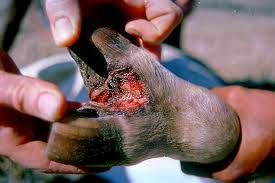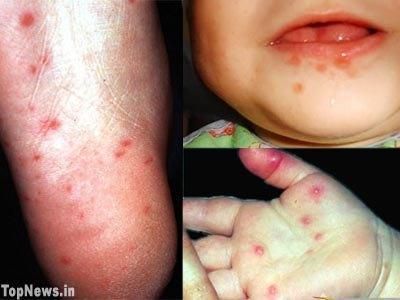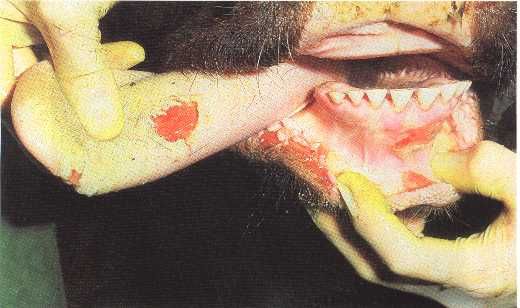The disease found in most parts of the world - the OIE lists at least 52 countries throughout Africa, the Middle East, Asia and South America that have reported the disease. There are seven serotypes of the virus: A, O, C, SAT1, SAT2, SAT3 and Asia1. These are further subdivided into more than 60 strains.
Clinical signs and symptoms
- Fever
- Bilsters in the mouth and on feet
- Drop in milk production
- Weight loss
- Loss of appetite
- Quivering lips and frothing of mouth
- Cows may develop blisters on teats
- Lameness

Transmission
The virus is extremely contagious
and spreads rapidly unless it is contained. It can
also be spread on wool, hair, grass or straw, by the wind or by mud or manure
sticking to footwear, clothing, livestock equipment or vehicles, as well as
most commonly through the movement of infected animals. Therefore, it usually requires
quarantining infected farms, followed by slaughtering and burning all
susceptible animals. Anyone having contact with animals in infected countries
should not go near susceptible animals for at least five days.
Pigs are regarded as amplifying hosts as they can excrete large quantities
of the virus in their exhaled breath. Cattle are able to be infected by
breathing in small quantities of the virus. The virus can be excreted by
animals for up to four days before clinical signs appear and some animals can
continue excreting the virus for long periods after apparent recovery.
FMD spreads rapidly especially in cool, damp climates or when animals are
penned or housed in cold weather. The virus survives well at temperatures below
4 degrees celcius, but is inactivated as temperatures rise. It is also rapidly
inactivated at relative humidity less than 60 per cent.
Treatment
Prevention
FMD is one of the most difficult animal infections to control. Good bio-security measures should be practiced on uninfected farms to prevent entry of the virus. Because the disease occurs in many parts of the world, there is always a chance of its accidental introduction into an unaffected country. Export restrictions are often imposed on countries with known outbreaks.
FMD outbreaks are usually controlled by quarantines and movement restrictions, euthanasia of affected and in-contact animals, and cleansing and disinfection of affected premises, equipment and vehicles.
Infected carcasses must be disposed of safely by incineration, rendering, burial or other techniques. Milk from infected cows can be inactivated by heating to 100°C (212°F) for more than 20 minutes. Slurry can be heated to 67°C (153°F) for three minutes. Rodents and other vectors may be killed to prevent them from mechanically disseminating the virus.
Vaccination
 FMD
vaccine is a killed preparation and, at best, affords good protection against
challenge for 4-6 months.
FMD
vaccine is a killed preparation and, at best, affords good protection against
challenge for 4-6 months.
Vaccination with one serotype does
not protect the animal against other serotypes, and may not protect the animal
completely or at all from other strains of the same serotype. Currently, there
is no universal FMD vaccine.
Human Transmission
Human infections have
been reported but they are very rare and do not result in serious disease.
Humans can carry the virus in their nose for up to 24 hours and can be a source
of infection for animals.
 Human foot and mouth disease
affects the inside of the mouth, the palm of the hands, fingers and soles of
the feet, mostly in children. Typical symptoms include a rash or ulcers in the
mouth, on the inner cheeks, gums, sides of the tongue, and bumps or blisters on
the hand, feet and sometimes other parts of the skin which may last seven to 10
days. Seek medical attention if you think you or your child may be affected.
Human foot and mouth disease
affects the inside of the mouth, the palm of the hands, fingers and soles of
the feet, mostly in children. Typical symptoms include a rash or ulcers in the
mouth, on the inner cheeks, gums, sides of the tongue, and bumps or blisters on
the hand, feet and sometimes other parts of the skin which may last seven to 10
days. Seek medical attention if you think you or your child may be affected.
Human foot and mouth diseases
are quite different and are caused by different organisms. Viruses from the group
called enteroviruses cause HFMD. FMD in livestock is not a threat to human
health.




No comments:
Post a Comment